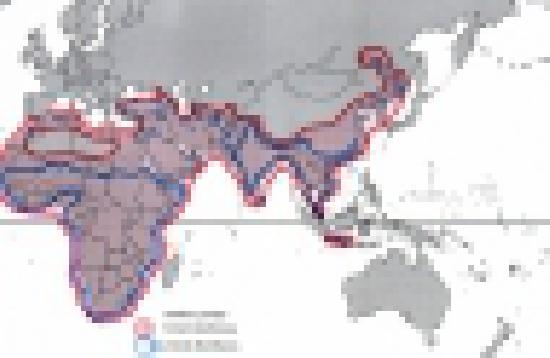English: Leopard or Panther; French: Léopard, Panthère, Panthère des Indes; Afrikaans: Luiperd; Amharic: Neber; Annamite: Con-beo gam; Arabic: Numer; Baluchi: Diho; Bahasa Jawa: Maung tutul; Bahasa Sunda; Macan tutul; Burmese: Kya-lak; Canarese: Keshal, Honiga; Chinese: Bao; Damara: garub, huiseb; Dekhani: Karda, Aonea, Singhal; Gonds: Burkal, Gordag; Hausa: damisa; Hebrew: Namer; Herero: Ongwe; Hindi: Sona, chitá, Tendua, Karda; Igbo: Odum; Iran: Palang; Iswana: Nkwe; Karens: Kiche-phong; Kashmiri: Suh; Kols: Teon-kula; Kiswahili: Chui; Korean: Pyo Bohm; Kuki: Kam-kei; Kung: Kum, kòéé g horn; Kwanyama: Ongwe; Lepcha: Syiak; Lozi: Ngwe; Maasai: Olowuana keni; Mahrati: Bibia-bagh; Malabari: Pali; Malay: Bimbau-bintan; Manipuri: Misi-patrei; Nagas: Kekhi; Nepali: Chituwa; Rajmehal: Jeskos: Russian: Wosstotsschnoss-sibirskij; Sindebele: Yingwe; Shangan: Yingwé; Shona: Ngwe, mbada; Singhalese: Kutiya; Sotho: Nkwe; Talain: Klapreung; Tamil: ciruttaippuli; Telegu: Chima-pali; Thai: Suo-Dao, Sua-Dam; Tibet: Shimi, Sik; Tuareg: damosa; Turkish: Pars; Urdu: Tendwa; Wolof: Segg, Tene; Xhosa: Ingwe; Zulu: Ingwe.
Former distribution: Africa, except Sahara desert, east to Asia, across Turkey, Transcaucasia to China and Korea, Amur-Ussuri, India, Indochina, Sri Lanka, Malaysia, Java: not in Sumatra.
Present distribution: Africa, south of the Sahara to the Cape Province in the Republic of South Africa. Small populations still abundant in Morocco, Algeria and Tunisia. Further east to Turkey, Sinai, Israel, Arabian Peninsula, Transcaucasia, Iraq, Iran and neighbouring regions of Turkmeniya in USSR, Afghanistan, Pakistan, India with Sri Lanka, to Indochina and South China, south to Malaysia and Java.
Behaviour: Preferred habitat: rain forest, deciduous forest, open woodlands, savannas, steppes, grassland, semi-desert areas, rocky hills and mountains, and swamps. They are good swimmers and excellent tree climbers: activity nocturnal: they usually hunt singly, waiting either at an ambush or stalking: diet includes – according to the habitat – antelopes, gazelles, young cattle, sheep, goats, ibex, deer, pigs, monkeys, hyraxes, birds, snakes, dogs, fish, jackals, foxes, porcupines, gorals and hares. The habit of tree „kills“ is widespread, mainly in Africa.
Population status: Stable, vulnerable, rare and endangered. Leopard populations have increased in many African countries over the last few years: their distribution is widespread and good numbers are being maintained, – such that – many authorities plan to reopen hunting on a quota basis for the cat species (Zimbabwe, Namibia, Kenya, Tanzania, RSA, Zambia, Sudan). In Ethiopia, Somalia, and Chad, Mali, Senegal and all coastal countries of West Africa their status is vulnerable or rare. They are greatly endangered in Morocco (50-100), Algeria (no records), Tunisia (no records), Turkey (15-23), Jordan (no records), USSR (no records), Sinai (1-2), Arabian Peninsula (10-15). No records from India, Indo-China, Malaysia and Java, or China. Estimate for the world’s population is 100 000: (DES CLERS, pers. comm. 1988) others state 250 000 (MACDONALD 1984). These figures seem to be very optimistic.
Brief notes:
Body weight: 50-70 kg
Head and body length: 100-190 cm
Tail length: 70-95 cm
Shoulder height: 45-80 cm
Gestation period: 90-105 days
Maximum age: 12 years (23 in captivity)
Trophy: Skull record CIC: 25.41 points, 1968 Iran, J. HEYDAYAT; average 23.00.
RW’s: 20″ 1958 India, C. PATIL; average 16″. RW’s: 19″, 1957 Tanzania, V. NEAMAND; average 15″. SCI: 19″, 1982 South Africa, J. RENEDO; average 15″.
Hunting methods: On a kill, from a hide, high seat, with beaters, dogs and traps, on elephant back.
Subspecies: 10; 5 Palaearctic, 2 Afro-tropical region, 3 Indo-Malayan region
1. Panthera p. panthera Morocco, Algeria, Tunisia. Endangered.
2. Panthera p. jarvisti Sinai. Endangered.
3. Panthera p. tulliana Israel, Lebanon, Jordan, Syria, Turkey, USSR; Transcaucasia and Turkmeniya, east to China. Endangered.
4. Panthera p. nimr Southern part of the Arabian Peninsula, Yemen, Muscat, Oman and northern Saudi Arabia. Endangered.
5. Panthera p. orientalis USSR, Amur-Ussuri region, northern Korea and in China; northern Heilongjiang (Manchuria). Endangered.
Afro-tropical region
6. Panthera p. pardus Africa: south of Sahara. Stable, vulnerable and rare.
7. Panthera p. adhersi Zanzibar. Probably extinct.
Indo-Malayan region
8. Panthera p. fusca India and Sri Lanka, Burma and south-western China. Rare.
9. Panthera p. delacouri Vietnam, Laos, Kampuchea, Thailand, Malaysia. Rare.
10. Panthera p. melas Java and Kangean Islands. Endangered.
Remarks: Most of the subspecies are endangered and declining in numbers. Hunting for fun, and their habit of attacking livestock may be one reason. However, leopards are highly adaptable in regard to human populations and the pressures of habitat destruction. The increase of livestock also means an increase of prey for these cats. In rare cases some leopards become man-eaters. Black panthers are present more in India, than in any other distribution areas. Acc. to GUGGISBERG (1975) the confusion concerning the validity of subspecies (30 are named) is still going on; the author recognizes only 10 as listed. A reclassification is long overdue.
